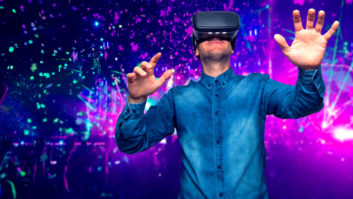Grigory Mindlin, general manager for broadcast at disguise, says that the dawn of AI is bringing new sorts of discussions into the broadcast industry… and that doesn’t have to be a bad thing!
What industry trends have particularly stood out for you in 2023, and why?
The most exciting technology that is trending in broadcast has to be AI by a long shot. Both in what is already possible and disrupting the industry today, and in the future innovations that are to come in the next two-to-three years.
Already, AI is enabling broadcasters to drive a new type of programming where virtual characters can interact with on-set talent, thanks to markerless mocap solutions like the disguise Invisible system. New audience engagement is also being driven by AI and enhanced data analysis. This is especially evident in sports where we are seeing live AI generated data and graphics overlaid into football coverage in real-time. We’re also seeing AI drive instant virtual backdrops, using technology known as NeRFs (neural radiance fields). This is enabling broadcasters to take images of the real world with the latest iPhone or another high-spec capture device, upload them onto an AI platform (for example, Volinga) and then transform that image into a 3D virtual scene in minutes.
What impact are you seeing those trends having on the media and entertainment industry?
The rise of AI is undoubtedly bringing new discussions into the industry, such as what impact AI will have on creative jobs. The way we see it, it doesn’t have to be a bad thing. In newsrooms, for example, where cost-saving is one of the biggest priorities, AI can help save journalists time on newsgathering to, instead, focus on diving deeper into stories. If AI can make news broadcasting an even more lucrative endeavour, then we’re bound to see more flexibility in the stories being reported. Combine this with new visual possibilities, such as new types of graphics, and news could become as entertaining as sports coverage.
How do you see those trends developing further in 2024?
We only see AI trends continuing to develop and be more accepted by different industry sectors. In sports broadcasting, for example, big names like the NFL, NBA and the Premier League have started to experiment with XR and AR, and the possibilities of what could be done in that field are endless. XR-based virtual human technology could help different sports engage new audiences. Imagine if anyone could drive fully virtual characters with their movements using AI, stepping into a MotoGP car and trying a circuit out for themselves, or if fans at home could sit on a digital seat within a game using their avatar, for example. These types of possibilities will continue to be explored.
Do you expect to see any new trends within the industry in 2024, and what will they be?
While these technologies promise to boost audience engagement for broadcasters, they could also power deepfakes for all sorts of purposes, so we expect to see even more discussions on regulations around AI and XR, so that they aren’t being used for misinformation, and aren’t replacing creatives’ jobs. With the right measures in place, these technologies could actually increase productivity and save money. Will AI replace humans in certain roles? Only those that require endless repetition and little human contact. Anything based on creativity should thrive in a world where our jobs can be enhanced by AI.






